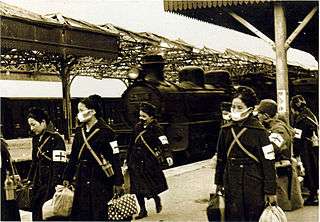JNR Class C51
The Class C51 (C51形) is a type of 4-6-2 steam locomotive built by Japanese National Railways (JNR). The C classification indicates three sets of driving wheels. The C51 introduced 1.75 m (5 ft 9 in) diameter driving wheels to Japan. C51s raised the average speed on the Tōkaidō Main Line from 47.3 km/h (29.4 mph) to 55.3 km/h (34.4 mph). In 1930, a C51 hauled the first Tsubame (swallow) express, reducing travel time between Tokyo and Kōbe to 9 hours.[1]
| JGR/JNR Class C51 Central China Ry Pashina class (パシナ) China Railways SL9 (勝利9) | |||||||||||||||||||||||||||||||||||||||||||||
|---|---|---|---|---|---|---|---|---|---|---|---|---|---|---|---|---|---|---|---|---|---|---|---|---|---|---|---|---|---|---|---|---|---|---|---|---|---|---|---|---|---|---|---|---|---|
Class C51 locomotive C51 5 at Ome Railway Park, May 2006 | |||||||||||||||||||||||||||||||||||||||||||||
| |||||||||||||||||||||||||||||||||||||||||||||
| |||||||||||||||||||||||||||||||||||||||||||||
| |||||||||||||||||||||||||||||||||||||||||||||
China Railway class SL9

To alleviate a severe motive power shortage, sixteen JGR Class C51 locomotives, C51 8, 28, 30, 33 - 35, 88, 95, 96, 116, 130 - 132, 173, 175, and 178, all equipped with a Sumiyama feedwater heater, were converted to standard gauge and sent to the Central China Railway in 1939, where they operated primarily between Nanjing and Shanghai, at first with their original JGR numbers, later as パシナ (Pashina) class. After the Liberation of China and the establishment of the People's Republic, these became China Railway class ㄆㄒ9 (PX9) in 1951, and reclassified as class SL9 (勝利9, Shènglì, "victory") in 1959.[2]
Preserved examples
As of 2012, four Class C51 locomotives were preserved at various locations.
- C51 5: At the Railway Museum in Saitama, Saitama (formerly preserved outdoors at the Ome Railway Park in Ome, Tokyo[3]
- C51 44: At Akita Depot in Akita, Akita[3]
- C51 85: At Kagoshima Depot in Kagoshima, Kagoshima[3]
- C51 239: At the Umekoji Steam Locomotive Museum in Kyoto[3]
References
| Wikimedia Commons has media related to C51 steam locomotives. |
- Naotaka Hirota Steam Locomotives of Japan (1972) Kodansha International Ltd. pp.57&96 ISBN 0-87011-185-X
- 中国蒸汽機車世紀集影 (Centennial Collection of Chinese Steam Locomotives), China Railway Publishing House, July 2001, ISBN 7-113-04148-5 (in Chinese)
- Sasada, Masahiro (September 2012). 国鉄&JR保存車大全 [JNR & JR Preserved Rolling Stock Complete Guide]. Tokyo, Japan: Ikaros Publications Ltd. p. 132. ISBN 978-4863206175.